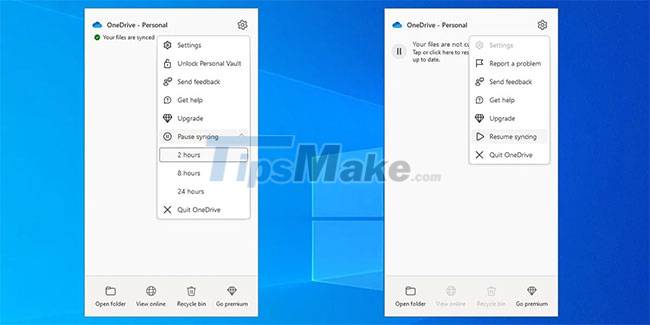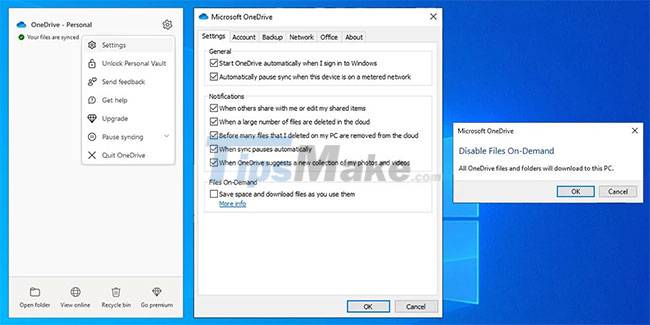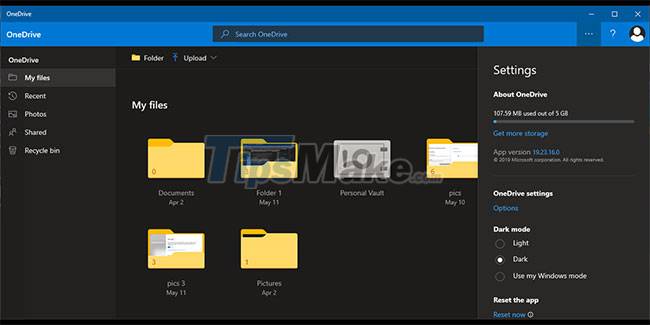Fix the error that OneDrive files or folders could not be deleted
If this happens to you, don't worry. Instead, explore all the solutions you can use to avoid filling up your cloud storage with obsolete or unnecessary files and folders.
1. Make sure the file is closed first
You may not be able to delete the file because a program is currently using it. Make sure you have closed the file on your device and ask other users in the network to close the file. Also, check if you have shared files with others and stop sharing files if you need to.
2. Check file and folder permissions
If the folder is shared with you by others, you may not have the necessary permissions to delete it, if someone changes the link permissions in OneDrive. You can ask the admin for permission or ask to delete the file for you.
3. Try deleting files from another device
If you're the admin of the file or have the necessary permissions but still can't delete the file, you can try deleting the file on another device. Since all OneDrive files and folders are synced everywhere, you can delete a file from your phone or another laptop.
4. Rename or move files or folders
This is an odd trick, but renaming a file sometimes allows you to delete a file that cannot be deleted. Select the file and press F2 or click Rename on the toolbar to change the file name. Then try to delete it
If this doesn't work, you can also try moving the file, which works for some people. Cut the file that you can't delete, paste it outside the OneDrive folder, then try deleting it again.
5. Pause OneDrive sync
If OneDrive is currently syncing folders, the app will prevent you from deleting files while it's active. However, you can temporarily stop syncing and delete files.
Follow these steps to stop OneDrive sync and delete folders:
Step 1: Open OneDrive from the taskbar.
Step 2: Click the Help & Settings icon, from the top right corner
Step 3: Click Pause syncing and choose how long you want to pause.
 Fix the error that OneDrive files or folders could not be deleted Picture 1
Fix the error that OneDrive files or folders could not be deleted Picture 1
Wait a moment after suspending OneDrive sync and trying to delete the file. If you want to continue syncing after deleting files, open OneDrive and click the Pause button. Or go to Help & Settings > Unpause sync.
6. Turn off Files on Demand
OneDrive's Files on Demand feature lets you keep your files or folders in the cloud and access them from your device without downloading them first. This is a great option if you want to free up space on your HDD or SSD: however, it can prevent you from deleting files. Here's how to turn off the Files on Demand feature:
Step 1: Right-click the OneDrive icon from the taskbar.
Step 2: Click Help & Settings > Settings.
Step 3: Select the Settings tab.
Step 4: Uncheck Save space and download files as you use them. If the option is already disabled, turn it on and off again.
Step 5: Click OK to save the changes.
 Fix the error that OneDrive files or folders could not be deleted Picture 2
Fix the error that OneDrive files or folders could not be deleted Picture 2
Once you've successfully deleted the file, go through the steps again and turn Files on Demand back on.
7. Reset OneDrive
If you still can't delete the file from your OneDrive, you should reset it. Fortunately, resetting OneDrive will not delete any of your folders or files. However, it will break all current sync connections, so you'll have to re-add the folders you want to sync.
Here's how to reset OneDrive:
Step 1: Open the OneDrive app.
Step 2: Click on the three-dot menu from the upper right corner.
Step 3: Select Settings.
Step 4: Click Reset now from the bottom of the menu.
 Fix the error that OneDrive files or folders could not be deleted Picture 3
Fix the error that OneDrive files or folders could not be deleted Picture 3
If Windows displays the error message Windows cannot find, launch Command Prompt with admin rights and run the command line C:/Program Files/Microsoft OneDrive/onedrive.exe /reset.
Delete files permanently
If you're having trouble deleting a certain file from OneDrive, you want to make sure it's gone forever. Once you have successfully deleted your OneDrive files or folders, there is an extra step to take if you want to delete them permanently. Launch the OneDrive app and from the menu on the left, open the Recycle Bin.
There you will see your deleted files. You can click Empty recycle bin and delete all files or select them individually before deleting.
Managing your OneDrive files can be difficult, especially if you have a lot of files and folders shared with others.
If you have the proper permissions and still can't delete the file, you can try one of the unusual fixes and rename the file or cut and paste it outside of OneDrive. In case this doesn't fix your problem, you can either reset the app or reconfigure its settings.
If you use OneDrive regularly, it's worth taking some time and learning more about its features, so you can get the most out of your account.
You should read it
- OneDrive launches file protection for Windows 10 users
- How to fix the problem of syncing OneDrive on Windows 10
- Steps to disable or completely remove the Onedrive application on Windows 10
- OneDrive is about to become the default folder in File Explorer on Windows 11
- Instructions for using OneDrive on iOS devices
- How to hide OneDrive from File Explorer in Windows 10
- 8 super useful things you can do with Microsoft OneDrive on Android
- Sync Desktop, Document, ... on Windows 10 with OneDrive
- How to delay starting OneDrive on Windows 10/8/7
- How to double OneDrive's free storage
- Get 100GB OneDrive for free from Samsung phones
- Just because of ransomware, OneDrive adds Files Restore feature to recover all data






 OneDrive launches file protection for Windows 10 users
OneDrive launches file protection for Windows 10 users 5 ways to share files and folders from OneDrive in Windows 10
5 ways to share files and folders from OneDrive in Windows 10 How to prevent Windows from saving files to OneDrive
How to prevent Windows from saving files to OneDrive How to Restore Deleted Files in OneDrive
How to Restore Deleted Files in OneDrive Recover deleted files from the cloud service
Recover deleted files from the cloud service How to recover deleted data on OneDrive
How to recover deleted data on OneDrive